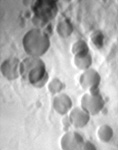Imaging Mercury in the Rhizosphere of Wetland Plants
summary written by Raven Hanna
High levels of mercury in our diets can have adverse effects on our health, and fish are a major source of dietary mercury. Because of a process called biomagnification, mercury levels in fish can build up to be at a much higher concentration than in the surrounding water. The mercury that accumulates in the tissue of fish is in the form of methylmercury, but this is not necessarily the chemical form that pollutes the water. Microorganisms living in the rhizosphere, or root zone, of plants are responsible for much of the methylation of mercury.
A team of researchers led by Joy Andrews of SSRL studied mercury uptake and methylation in the rhizospheres of two common plant species in the San Francisco Bay. They used a combination of experiments to piece together the story of methylmercury formation. Using data collected at SSRL Beam Lines 9-3 and 10-2, they used Hg L3 x-ray absorption edge spectroscopy (XANES) to determine what species of mercury were present in the root systems. They used Beam Line 2-3 to perform scanning x-ray fluorescence (XRF) and micro-XANES experiments to map the location of mercury species within the roots of the plants. Additionally, they performed transmission x-ray microscopy (TXM) experiments using Beam Line 6-2c, which showed that the mercury seen in the roots was most concentrated on the outside of microorganisms.
The researchers conclude that much of the mercury is binding to sulfur in the plant roots and microbes' cell walls, and about 10% of the total mercury is likely to be methylated. Because these plants dominate the San Francisco Bay environment, their rhizospheres could be a significant source of methylated mercury in this estuary ecosystem. This work was published in the September issue of Environmental Science & Technology.
To learn more about this research see the full Scientific Highlight
Patty C, Barnett B, Mooney B, Kahn A, Levy S, Liu Y, Pianetta P, Andrews JC (2009) Using X-ray Microscopy and Hg L3 XANES to study Hg Binding in the Rhizosphere of Spartina Cordgrass. Environ Sci Technol 43: 7397-7402.


